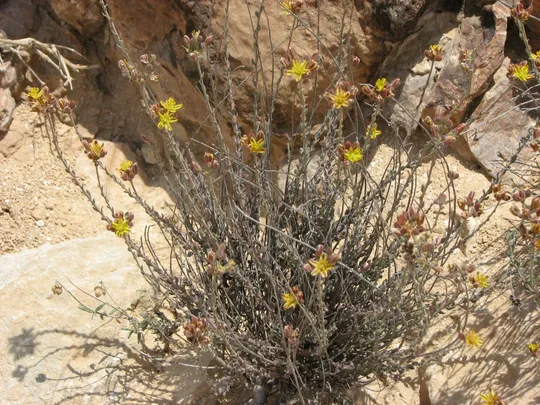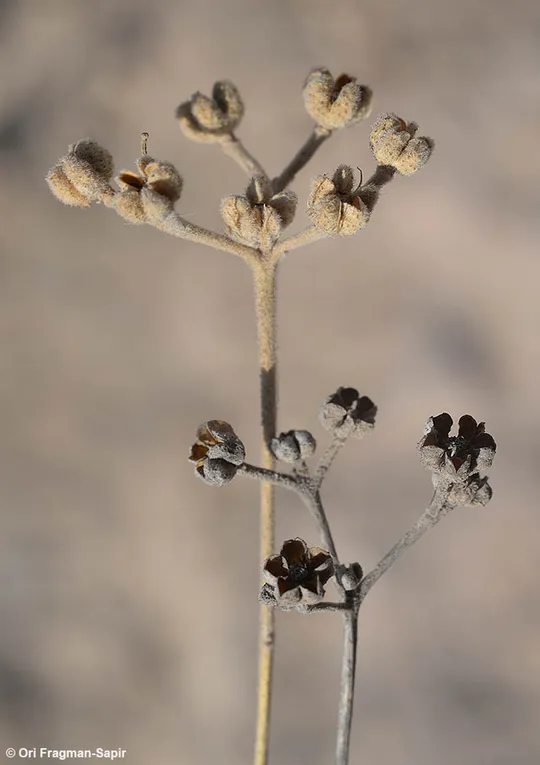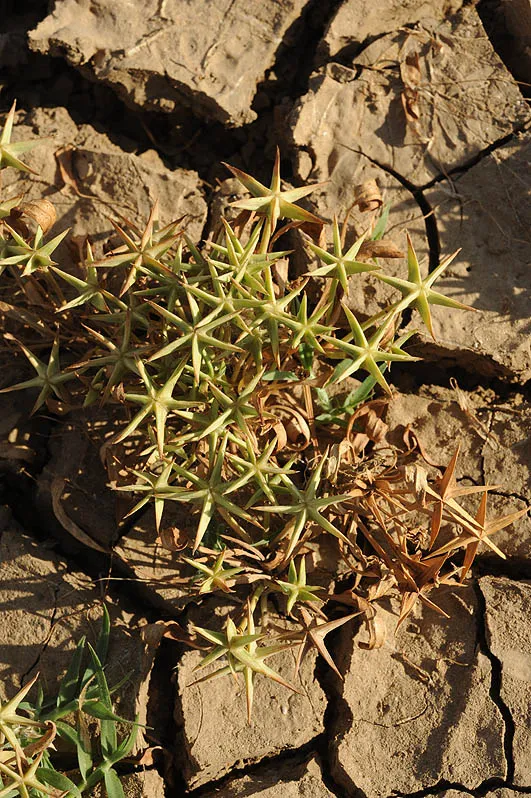Haplophyllum poorei



Haplophyllum poorei grows in the
Negev Highlands and in the southern Negev on 17 documented sites and according
to estimates, there are 25 sites. Sixteen sites were recorded in the high Negev
Highlands – in the Mount Nafha area, Lots Cisterns, Mount Horsha, Rosh Elot, Mount Lots, Wadi Eliav and Mount Romem, where
in fact they constitute one large segment, almost always at an altitude of
nearby section is the Wadi Akrav basin. In the southern Negev, H. poorei
is found only on Mount Nes, which is in fact (geologically and
geomorphologically) a continuation of the Negev Highlands.
Rock pockets on cliffs and rocky expanses in the high
Negev Highlands, usually above an altitude of
company of Chiliadenus iphionoides and Pistacia atlantica that are
characteristic of the rock vegetation of the high Negev Highlands.
The genus
Haplophyllum contains some 65 species prevalent in the deserts
and semi-deserts of North Africa and Central and Western Asia.
Zohary and Danin described the H. poorei populations in the
Negev Highlands as an endemic subspecies – H.poorei ssp. negevensis. It differs
from the characteristic subspecies that grows in Edom in its hairy anthers and its
ovary that includes simple hairs in addition to glandular hairs. H. poorei is very close to H. fruticulosum, a species with a western Irano-Turanian
distribution that also grows in Edom. Zohari stressed in the Flora that it is
very close to H. poorei but differs from it in several characters: the ovate
leaves, the form of the calyx
lobes and the corolla, the capsule teeth that lack rays and the leaf shape
which is cylindrical not club-shaped.
The shape of the fruit of H. poorei places it among
the species with the most ancient features in the genus, and suggests that it
is ecologically close to the fruit of Delphinium and Nigella from
the Ranunculaceae family. This could be a case of ecological convergence of
taxonomically distant genera, which expresses an adaptation for storing a
single seed in each of the fruit valves, which does not open during dispersal.
In Edom, on the same the sandstone substrate in addition
to H. poorei,
H. fruticulosum also grows. All efforts to find and study the two
species in Edom were unsuccessful. If in Edom there is no clear distinction between
the two Haplophyllum species, H. poorei will become a subspecies of H.
fruticulosum and its
status as a "red" species will change.
·
Haplophyllum poorei was described as
a new species for Israel only at the end of the 1960s, and there are no known
changes in the number of regions and sites since then.
·
The species generally appears in small
populations composed of individual plants.
·
H. poorei usually grows in natural sites where
no significant disturbance is expected, if at all, and some of the sites are
not easily accessible.
·
Most of the populations are protected
in the Negev Highlands Reserve.
·
H. poorei is endemic to Israel and Jordan and its
local threat status is equivalent to its global one.
A regular monitoring program should be established for some representative populations in the high Negev Highlands, for a long-term study of individual and population development trends.
Haplophyllum poorei is endemic to
Jordan and Israel. In Jordan, it grows in Edom and in Israel only in the Negev
Highlands. In Edom, it grows on hard sandstone and in the Negev Highlands on limestone.
Zohari described the chorotype of the species as western Irano-Turanian despite
it being endemic to Desert Mountains in the Saharo-Arabian phytogeographic area.
Haplophyllum poorei is a small
shrub that grows in the
high Negev Highlands on several dozen sites. The populations at these sites are
not faced by an immediate threat to as there is little danger of damage to its
habitat. The inclusion of the species in the endangered species list is a result
of its status as an endemic subspecies to the Negev Highlands in Israel. If taxonomic
research will show that H. poorei is a subspecies of H. fruticulosum, its status will
change, which will affect
its level of endemism and consequently its red number
Current Occupancy Map
| 1000 squre meter pixel | 5000 squre meter pixel | 10000 squre meter pixel | |
|---|---|---|---|
| number of observations | 0 | 0 | 0 |
| in total pixels | 0 | 0 | 0 |
| Family | Rutaceae |
| Classification | On the near threatened species list |
| Ecosystem | Desert |
| Chorotype | Western Irano - Turanian |
| Conservation Site | Wadi Elot near Rosh Elot |
| Rarity |
1
1
6
|
|---|---|
| Vulnerability |
0
0
4
|
| Attractiveness |
0
0
4
|
| Endemism |
0
2
4
|
| Red number |
1
2.1
10
|
| Peripherality | E |
| IUCN category | DD EW EX LC CR EN VU NT |
| Threat Definition according to the red book | Least concern |
 Based on:
Based on:






